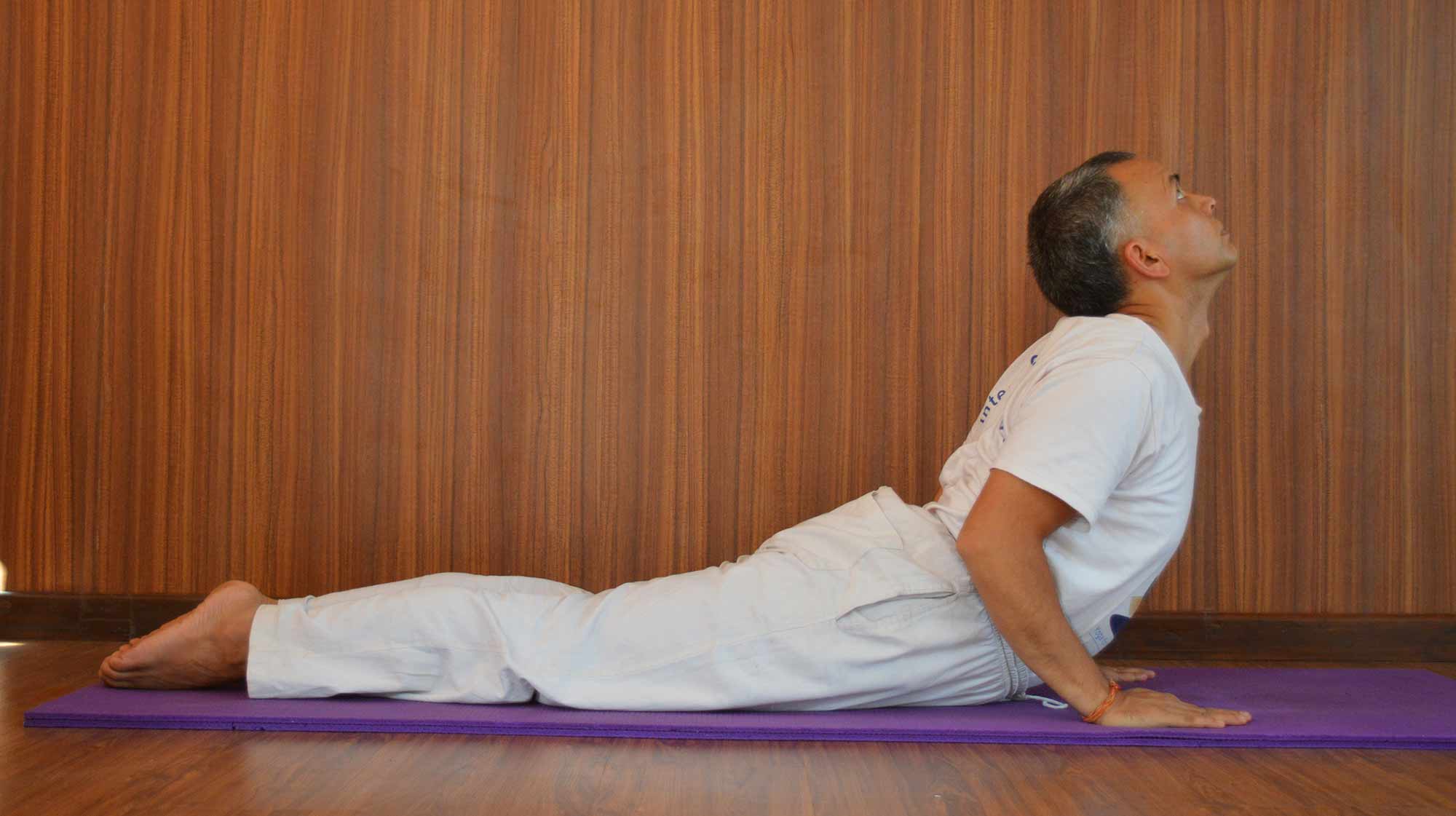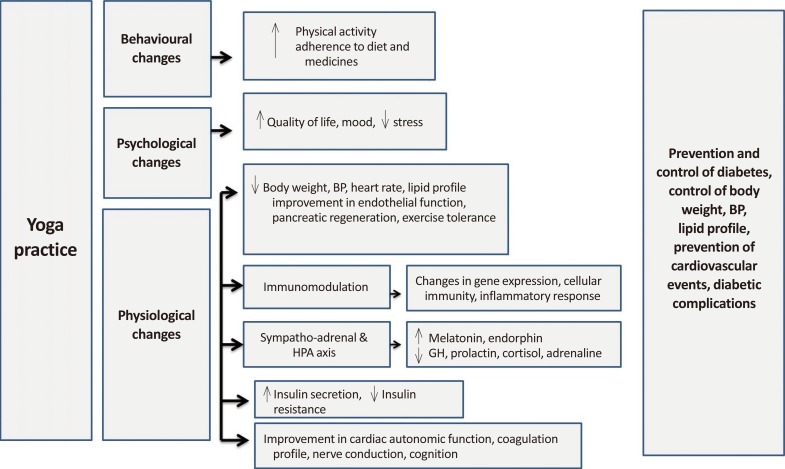
24 Oct 2024 HYN Himalayan Yoga Academy
Diabetes is one of the most common non-communicable diseases, and globally, it affects many people. It is defined as impaired insulin production, decreased insulin sensitivity, or low insulin resistance, which leads to high blood glucose levels. Living with and managing diabetes can be challenging, but there are natural remedies to help regulate blood sugar levels. Hence, it is manageable as Yoga for Diabetes is a common approach nowadays.
As per several studies and research articles, diabetes patients are believed to benefit greatly by living a more active lifestyle and exercises that support one’s physical and mental health simultaneously. As well as the importance of interventions, lifestyle changes, and a balanced diet to manage diabetes, yoga also plays an important role in helping to control blood sugar levels naturally. Yoga is the practice of physical and mental wellbeing providing a holistic approach to health. It is a great way to manage diabetes naturally.
Benefits of Yoga in Diabetes
Yoga can help by improving blood sugar levels, increasing insulin sensitivity, and more. It can help block and reduce stress hormones (cortisol and adrenaline) which is also one of the many factors that can contribute to insulin sensitivity. Some of the benefits of yoga in controlling diabetes are as follows:
- Improves insulin sensitivity: Yoga helps your body use insulin more efficiently, which means better blood sugar control.
- Reduces Stress: Stress can raise your blood sugar. Yoga helps calm the mind and reduces stress, preventing the increase.
- Helps with weight loss: Maintaining weight is important for managing diabetes, and yoga can also help with activeness and fitness.
- Improves circulation: Yoga keeps your blood flowing, which helps insulin to pass through your body more efficiently.
- Improves overall health: Yoga improves flexibility, energy, digestion, and even sleep which is very important in managing diabetes.
How does yoga help in diabetes control?
It is hypothetical to know that yoga meditation is the root solution to every problem that exists in both physical and spiritual elements and makes you think like oh my god when you know how it performs in your body with zero side effects. There are thousands of yoga Asana to balance and connect the inner consciousness with the cosmology. Similarly, Yoga is a universal self-practice that can reduce and control any physical and mental instability for better performance.
Yoga asanas are the perfect way of controlling diabetes which involves combining yoga poses, and divine practice with breathing techniques. Yoga Asana like Trikonasana (Triangle pose), Bhujangasana ( cobra pose), Setubandhasana (like bridge pose), and other fundamental postures not only increase the flexibility and strength of the body, mind, and soul but also improve the circulation and stress reduction, whereas vital for sugar management.
Cooperating with a breathing exercise known as pranayama such as Nadi Sodhana (alternative nostril breathing technique) and Ujjayi breath (Victorious breath) constantly helps calm the mind and regulate metabolism. The regular practice of increased consistency makes it flexible to guide or monitor how Yoga asana affects blood sugar levels. It also integrates tranquil mindfulness and deep meditation, which enhance well-being to control stress and support diabetes management. It plays a significant role in emotional well-being and better consciousness, and can greatly affect diabetes. Thus, it is an essential approach to yoga to complement a balanced diet, schedule fitness activities, and prescribe medication. It can improve your overall fitness, maintain a healthy weight, and body function.
Tips and techniques of diabetes control with yoga practice
Controlling diabetes with yoga can be an alternative beneficial for a compressive management plan—essential tips and techniques.
- Choose the right Posture to improve blood circulation and reduce stress. It involves asana like Trikonasana, Paschimottasana, Bhujangasana, Vrikshyasana, and Tadaasana to balance strength and stability.
- Practice breathing techniques is essential which helps for better metabolism through Pranayama.
- Divine mindfulness and meditation are crucial for managing high stress and connecting your emotional well-being with yoga and energy.
- Monitor blood sugar levels in your body and know ow how yoga helps to improve diabetes and improve fitness.
- Focus on a healthy lifestyle with daily exercise, meditation, nutritious food, and necessary Medicare.
Yoga Asana for Diabetes
Different aspects of Yoga help in the management of diabetes:
1. Asanas (Yogic Asanas & Sequence)
Asanas emphasize the relationship between body, mind, and consciousness and focus on synchronizing breath with movement. They include stretching, twisting, and relaxation. The key to performing yoga postures is to be steady and comfortable. Seated postures like Ardhamatsyendrasana, Yoga Mudra, and Mandukasana improve pancreatic function. Asanas involve forward bending massage and compress the pancreas, stimulating insulin secretion. Twisting poses such as Vakrasan and Ardamatsyendrasan (seated spinal twists) compress and massage the intestines, preventing stagnation of colonic contents.
To achieve therapeutic benefits, poses should be held for approximately 30 seconds to 1 minute depending on the individual’s capabilities, but the duration can be gradually increased. A study showed that yoga poses have a positive effect on glucose utilization and fat redistribution in type 2 diabetes patients [11]. In diabetic patients, the alternating abdominal contraction and relaxation associated with yoga practice may rejuvenate pancreatic cells and increase the sensitivity of pancreatic beta cells. Improved blood supply to muscles increases the expression of insulin receptors in muscles, increasing glucose uptake.
a. Surya Namaskar (Sun Salutation)

Surya Namaskar (Sun Salutation) is a complete series of postures. It is an excellent exercise that takes only a few minutes to do and serves as a warm-up routine before the practice of yoga asanas. It highly helps in the maintenance of Diabetes. It is one of the best home exercises requiring little space, only eight by three feet. Be sure to have enough space to lie down, and enough clearance to stretch the arms above the head while standing. It consists of 12 series of postures that are performed continuously and combined with synchronized breathing. Each position counteracts the preceding one producing a balance between flexions and extensions.
b. Paschimottasana

c. Bhujungasana

d. Ardha Matsyendrasana (Seated spinal twist)
Other important yoga asanas for diabetes that should be done by people with diabetes are :
- Dhanurasana – Bow Pose
- Ushtrasana – Camel Pose
- Vakrasana
- Naukasana – Boat Pose
- Parvatasana – Mountain Pose
- Danda & Baithak
- Shavasana
- Mandukasana – The Frog
- Biparita Karani
2. Pranayama
Pranayama is the practice of controlled or regulated yogic breathing. The slow breathing techniques of Pranayama bring about comprehensive changes in the body’s physiology through control of the autonomic nervous system. They regulate breathing rate and pattern and regulate heart rate and its variability. Pranayamas help in the management of diabetes as:
- It impacts the neuronal activities of the brain centers, including those present in the limbic areas, hypothalamus, and medulla, as well as improving sympathovagal outflow.
- Improves cardiorespiratory endurance, flexibility, and helps reduce the percentage of body fat.
- It helps in the regulation of the pineal, pituitary, and adrenal glands, which play an important role in the regulation of metabolism
Different Pranayama Kriya that helps in the Management of Diabetes are :
- Kapalbhati
- Agnisar kriya
- Anulom vilom – Alternate Nostril Breathing
- Bharamari – Humming Bee Breathing
- Chandra Bhedan – Moon Breathing
- Surya Bhedan – Sun Breathing
- Bhastrika ( bellows breath)
3. Meditation (Dhyana)
Meditation has been proven to cause physiological changes in the brain. Meditators experience positive psychological effects, such as B. Faster reaction to stimuli and less susceptibility to various forms of stress. The mental stability gained through meditation practice helps diabetic patients. Six weeks of meditation and Sahaja Yoga meditation treatment have shown an improvement in quality of life, reduction in anxiety, and blood pressure control. Visualizing and concentrating on the pancreas during meditation is recommended for the treatment of diabetes, as it has a positive effect on blood sugar levels. Mindfulness exercises have been recommended for people with diabetes and coronary heart disease to improve sleep, become more relaxed, and be more accepting of their experience of illness and disease.

4. Yogic Cleansing Practices ( Yogic Suddhi Kriyas )
| Kapalbhati (frontal brain purification) | 5 rounds, 120 strokes |
| Agnisar kriya (stimulating the digestive fire) | 5 rounds |
| Vaman dhauti (stomach cleansing) | Once a week |
| Full shankhaprakshalana (intestine cleansing) | Once a year |
| Laghu shankhaprakshalana (short cleansing) | Every 40 days |
5. Mudras & Mudra for Diabetes
Mudras (Gestures) Mudras are combinations of subtle physical movements that change mood, posture, and perception and deepen awareness and concentration [28]. Some hasta mudras (hand movements), such as linga mudra, Surya mudra, and prana mudra, are thought to be helpful for diabetes. Regular practice of these mudras boosts metabolism, promotes weight loss, and lowers blood sugar levels. Certain other mudras, such as apan mudra and gyan mudra, are recommended for diabetics for deep relaxation and stress relief.
Frequently asked questions for diabetes control with Yoga Kriya
Is Yoga really, good for diabetes control?
Yoga is the combined practice of science and art that showcases how things can be balanced by practicing yoga and meditation in a short time. If you are suffering from diabetes, practicing yoga regularly can increase insulin receptors, balance insulin glucose levels in the blood, and improve insulin activity.
How does Yoga help in managing diabetes?
Yoga works to lower stress, and anxiety, improve insulin sensitivity, and metabolism function, and also focus on overall well-being.
What kind of yoga poster is good and effective for diabetes?
There are several poses including the Reclined Bound Angle pose (Stupa Baddha Konasana), Dhanurasana (Bow pose), and Paschimottasana were highly recommended by experts.
Can yoga replace medication for diabetes?
Yoga is a traditional process of controlling diabetes rather than a substitute. As with many research and traditional yoga scriptures, it can be recovered totally.
Is yoga safe for all kinds of diabetes?
Yoga is safe for any diabetes people, but make sure to yoga experts and health consular while practicing new yoga or any exercise.
Can yoga, meditation, and breathing exercises in yoga to help with diabetes?
Proper meditation and breathing exercises like pranayama are worth it for diabetes. It has a positive impact on diabetes.
How long a yoga season is perfect for diabetes management?
Normally, a season of around 1 hour to 1. Hours 30 minutes can be surely effective by following proper poses, mindfulness, relaxation, and breathing techniques.
Conclusion: Yoga For Diabetes
At last, remember to listen to your spiritual body, adopt your practice, and enjoy the benefits that yoga brings to your journey of diabetes management with the ancient practice of yoga. It is a holistic approach that aids in claiming the nervous systems and enhancing respiratory efficiency. You always have the power to choose your next steps so surround yourself with yoga and meditation and improve all your wellbeing. Here Himalayan Yoga Academy is always ready to work with you for a healthy world and happier people. Be ready to create your conscious journey with us.
Regular yoga practice reduces the risk of diabetes-related complications. Cardiac autonomic dysfunction is believed to be a cause of sudden death in diabetic patients. Clinical studies have shown that regular yoga exercise improves cardiac autonomic function and reduces the risk of cardiovascular events, independent of glycemic control.
